Exploring Italy by Train
During our first visit to Italy several years ago, my husband Fred and I became infatuated with everything about this charming country of Fred’s ancestry.
We have revisited there numerous times since to experience the customs, marvel in the architecture and history, and best of all, to enjoy the food. We have returned from each trip with many fond memories, but one trip which stands out is a train trip we made through Northern Italy.

When I made the suggestion to Fred that we do the train trip, I had never even been on a train. The thought of using that mode of transportation in a country we had only begun to know was a bit intimidating. But, I had read that train travel in Europe is safe and efficient, so it likely would not be any more challenging than touring by auto, which we had done a couple of times. And, it offered some advantages: we wouldn’t get lost, something which had frequently happened in our auto trips; there would be no long searches for parking places; and we could sit back, relax, and enjoy the scenery instead of fumbling with maps and watching for signs, all while being wary of the infamous Italian drivers. The decision was made, and the planning began.
We planned a flexible itinerary in a big circle beginning and ending in Milan, along the main train routes of the area, which would limit the number of connections we needed to make. Our route would take us east to Venice, then head southwest to the Mediterranean coast, then north to the Piedmont region before returning to Milan and our flight home. We did research on the main towns along the route, choosing a number of possible destinations, but decided to forego making reservations other than for the night of our arrival, preferring to decide as we went where to stay. Because it was Spring, we anticipated no problem finding accommodations along the way. Our first night was to be spent in Verona, an hour by train from Milan.
Rail passes, which would enable us to board trains without purchasing individual tickets for each destination, seemed convenient and less confusing for two rail travel novices. Although more expensive, we realized they were indeed a good investment when we saw the long lines at the station ticket windows during our journey.
seemed convenient and less confusing for two rail travel novices. Although more expensive, we realized they were indeed a good investment when we saw the long lines at the station ticket windows during our journey.
A few weeks before our trip, Fred purchased 2 large backpacks, much to my surprise. He explained that since we were traveling by train, we couldn’t be hauling heavy suitcases through the stations and narrow rail cars. While it was a good point, I had trouble envisioning us, two middle-agers, backpacking through Italy. However, there was something adventurous about the image, so I agreed. Packing lightly for our two week trip was a challenge, but there were several times during our journey that I would credit Fred for this wise decision.
Arriving early in the morning in Milan, we took a bus from the airport to the main train station. Milan actually has 3 stations, a fact we hadn’t known, but we guessed correctly that we wanted Stazione Centrale. We learned our first lesson- most cities have multiple stations, so we needed to know which was the correct one for our destination. Once at Centrale, we had our rail passes validated, and looked for the train to Verona. In the huge station, everything was very clearly marked, and we easily found the correct train. Hoisting myself up the steps of the car, I was grateful I wasn’t encumbered by a suitcase.
We relaxed in a comfortable first-class compartment, and enjoyed the scenery as the train sped through the

countryside. To the North we could see the steep Dolomite mountains, while South of us was vast, flat farmland. We soon arrived in Verona, and took a taxi to our hotel in the center of the city, convenient to everything. Although this city is known for its Romeo and Juliet association, it has much more to offer. Next to our hotel, on the banks of the Adige River, stood the Castelvecchio, a castle complete with moat and drawbridge. It now houses an impressive art museum. Around the corner is the well-preserved pink marble Roman amphitheatre in the main piazza. It is still in use as an Opera house, and a production of Aida was showing while we were there. That evening, we sat at a nearby outdoor cafe and listened to the music drifting over the amphitheatre walls.
The main shopping street, Via Mazzini is closed to traffic and offers a perfect place for an after dinner stroll. At the end of the street was the Piazza della Erbe, a lively place with market stalls selling everything from fresh produce to tacky souvenirs.
Our next stop was Padua, which we had no great desire to visit, but it was only 1/2 hour by train to Venice, and would offer a convenient, economical base from which we could make a visit there. We had no reservations, and exiting the station we spotted a hotel a short walk away. After leaving our backpacks in the room of this clean and inexpensive hotel, we headed into town for lunch and a look around. In the center, we discovered another Piazza della Erbe, a bustling marketplace. There was also a produce market in the Piazza della Frutta, where we stopped for lunch at an outdoor cafe overlooking the market activity. While we enjoyed our lunch, the vendors packed up their produce, stands, and umbrellas and left, leaving behind an empty parking lot. Afterwards, we explored the heart of the city, marveling at its arcaded streets, attractive Basilica, and statues by Donatello.
After dinner in our hotel, we took an evening stroll, and discovered a drawback to staying in the neighborhood of a train station- at night the streets were lined with prostitutes. We quickly headed back to our room, and decided not to stay near a station in the future.
The next day promised to be the highlight of our trip- a day in Venice. We hopped aboard the train in the
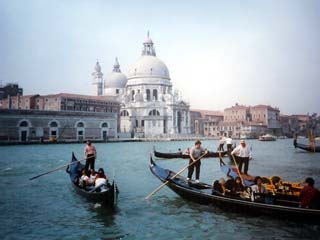
early morning and were soon there. Venice’s Stazione Santa Lucia is right on the Grand Canal. We boarded a water bus bound for the Piazza San Marco, the main square. The bus, or vaporetto, worked its way leisurely down the canal making numerous stops along the way. The ride afforded us views of luxurious palaces, countless gondolas, and picturesque side canals. I quickly used up a roll of film. We floated beneath the famous Ponte di Rialto and the lesser known Ponte dell’Accademia, before pulling up to the San Marco stop.
The Piazza San Marco is an incredible and impressive sight. It is surrounded by the Basilica and arcaded buildings housing two elegant outdoor cafes across the square from one another, each with an orchestra playing. The center of the square was mobbed with flocks of pigeons and picture-taking tourists. Very few people were actually sitting in the cafes, and one look at the prices on the menus explained why! We took an elevator to the top of the Basilica’s bell tower, from where we had magnificent views of the city and canals.
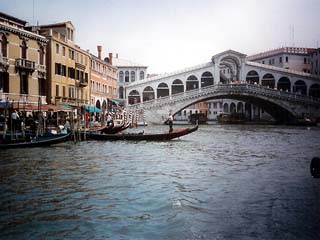 After exploring the side streets and canals for the morning, we found ourselves at the Rialto bridge around Noon. There were several restaurants in the area, and we chose one tucked into an alcove alongside the bridge. Serenading gondoliers floated past us as we dined, making it a very romantic experience. The rest of our day was spent getting pleasurably lost in the labyrinth of small canals, tiny bridges, and narrow alleys. We returned to Padua in the early evening, exhausted but thrilled to have seen such a magnificent place.
After exploring the side streets and canals for the morning, we found ourselves at the Rialto bridge around Noon. There were several restaurants in the area, and we chose one tucked into an alcove alongside the bridge. Serenading gondoliers floated past us as we dined, making it a very romantic experience. The rest of our day was spent getting pleasurably lost in the labyrinth of small canals, tiny bridges, and narrow alleys. We returned to Padua in the early evening, exhausted but thrilled to have seen such a magnificent place.
Our next destination was the much smaller city of Ferrara. It was the weekend, and the train was mobbed. We were unable to find a place to sit, so made the first leg of the trip standing in the gangway. Luckily, the ride was short. Once there, we tried a new plan for finding a hotel. We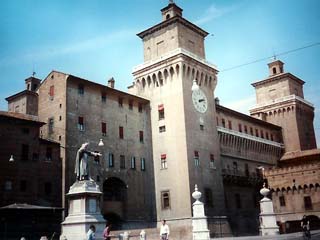 asked a taxi driver to take us to the Tourist Office, which was near the center of the city. There we were given information on local accommodations, and chose one in our price range. They called ahead to make reservations for us, and we walked the short distance to the hotel where we were given a room with a small balcony that overlooked the city’s castle. The Castello Estense is located in the center of the walled-in city, and is open to visitors. The center is closed to traffic, and we relaxed there at an outdoor cafe, where we were amazed to see business men in suits, housewives with shopping bags, and young women with tight skirts and heels zipping past us on bicycles.
asked a taxi driver to take us to the Tourist Office, which was near the center of the city. There we were given information on local accommodations, and chose one in our price range. They called ahead to make reservations for us, and we walked the short distance to the hotel where we were given a room with a small balcony that overlooked the city’s castle. The Castello Estense is located in the center of the walled-in city, and is open to visitors. The center is closed to traffic, and we relaxed there at an outdoor cafe, where we were amazed to see business men in suits, housewives with shopping bags, and young women with tight skirts and heels zipping past us on bicycles.
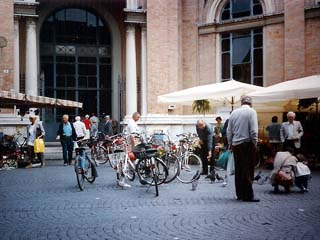 We successfully utilized our new strategy for finding hotels at our next few stops, Ravenna and Bologna. Ravenna has a renowned collection of Byzantine mosaics, and is also where Dante is entombed, but I was most impressed by it’s lovely flower market. Bologna is famous for it’s cuisine, and we certainly enjoyed trying out their most famous dishes, but there is much more to appreciate besides food. Its sidewalks are covered with porticoes, many with frescoes. At the Basilica di San Petronio, the biggest church in the city, the ceiling frescoes were being painstakingly restored by art students from the local university. Bologna also has 2 leaning towers, one which we climbed for an overview of the city.
We successfully utilized our new strategy for finding hotels at our next few stops, Ravenna and Bologna. Ravenna has a renowned collection of Byzantine mosaics, and is also where Dante is entombed, but I was most impressed by it’s lovely flower market. Bologna is famous for it’s cuisine, and we certainly enjoyed trying out their most famous dishes, but there is much more to appreciate besides food. Its sidewalks are covered with porticoes, many with frescoes. At the Basilica di San Petronio, the biggest church in the city, the ceiling frescoes were being painstakingly restored by art students from the local university. Bologna also has 2 leaning towers, one which we climbed for an overview of the city.
 After several days of train travel without any problems, we were becoming increasingly confident. We next headed to Reggio Emilia in the heart of the Emilia-Romagna region. We weren’t sure that we would want to stay here, so we used the baggage depository of the train station to hold our backpacks while we looked around. We took a leisurely walk to the center and toured its 3 large piazzas, churches, and octagonal bell tower. The produce market was set up in one of the piazzas, and we picked up some fresh items for an al fresco lunch by a small fountain. Returning to the train station in the early afternoon, we retrieved our baggage and moved on to Parma. A taxi dropped us off at the Tourist Office, but to our chagrin, it was closed for siesta. We had gotten accustomed to shops being closed in the afternoon, but hadn’t given it a thought regarding the Tourist Office. Not wanting to sit for an hour or so in the hot sun waiting for it to reopen, we set off on foot to try to find a place to stay. Again, I was grateful for the backpacks, since I couldn’t imagine lugging suitcases around the city streets. Fortunately, prominently posted signs indicated the various hotels around town. The first one we reached was full, but the next had a room.
After several days of train travel without any problems, we were becoming increasingly confident. We next headed to Reggio Emilia in the heart of the Emilia-Romagna region. We weren’t sure that we would want to stay here, so we used the baggage depository of the train station to hold our backpacks while we looked around. We took a leisurely walk to the center and toured its 3 large piazzas, churches, and octagonal bell tower. The produce market was set up in one of the piazzas, and we picked up some fresh items for an al fresco lunch by a small fountain. Returning to the train station in the early afternoon, we retrieved our baggage and moved on to Parma. A taxi dropped us off at the Tourist Office, but to our chagrin, it was closed for siesta. We had gotten accustomed to shops being closed in the afternoon, but hadn’t given it a thought regarding the Tourist Office. Not wanting to sit for an hour or so in the hot sun waiting for it to reopen, we set off on foot to try to find a place to stay. Again, I was grateful for the backpacks, since I couldn’t imagine lugging suitcases around the city streets. Fortunately, prominently posted signs indicated the various hotels around town. The first one we reached was full, but the next had a room.
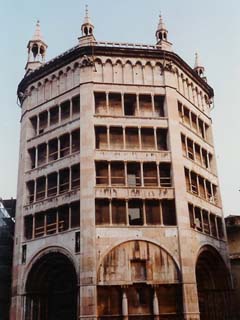 This was our second visit to Parma, and there was something comforting about returning to a place with which we were already familiar. I’ve never understood why Parma is not on the average tourist’s itinerary. It is the quintessential Italian city, offering something for everyone: art galleries, museums, a theatre, interesting architecture, the birthplace of Toscanini, parmigiano cheese, and parma ham. The octagonal pink marble baptistry is my favorite, although it seems to be perpetually encased in scaffolding and netting as restoration is done on the building completed in 1260. The streets are literally clogged with bicycle traffic. We enjoyed sitting at a sidewalk cafe in the old town center during the early evening, when it seemed that everyone in town was out for the passagiata, a traditional evening stroll. The Italians had won a major international soccer tournament, and there was a riotous celebration in the streets that lasted well into the night. The Italians certainly take their soccer seriously!
This was our second visit to Parma, and there was something comforting about returning to a place with which we were already familiar. I’ve never understood why Parma is not on the average tourist’s itinerary. It is the quintessential Italian city, offering something for everyone: art galleries, museums, a theatre, interesting architecture, the birthplace of Toscanini, parmigiano cheese, and parma ham. The octagonal pink marble baptistry is my favorite, although it seems to be perpetually encased in scaffolding and netting as restoration is done on the building completed in 1260. The streets are literally clogged with bicycle traffic. We enjoyed sitting at a sidewalk cafe in the old town center during the early evening, when it seemed that everyone in town was out for the passagiata, a traditional evening stroll. The Italians had won a major international soccer tournament, and there was a riotous celebration in the streets that lasted well into the night. The Italians certainly take their soccer seriously!
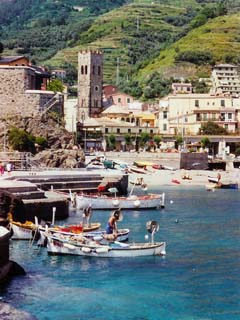 The next leg of our journey would take us through the Apennines to the Ligurian coast, where we were to spend a few days in Cinque Terre, five fishing villages along the rocky, mountainous Mediterranean coast which have only recently been “discovered” by American tourists. They do not allow cars in these towns, so we had bypassed them on previous trips, but I had long wished to visit. Our trip took us through dozens of tunnels, offering scenic mountain views in between. We switched trains in the city of LaSpezia, needing to take a small local train to our destination, Monterosso al Mare. While we waited for the train, we decided to save ourselves time by calling ahead for a hotel room. After trying a few places without luck, the desk clerk at the third hotel said they were full but he had an apartment we could rent. The price was reasonable, and although we were somewhat apprehensive, the prospect of staying in our own apartment was intriguing, so we agreed.
The next leg of our journey would take us through the Apennines to the Ligurian coast, where we were to spend a few days in Cinque Terre, five fishing villages along the rocky, mountainous Mediterranean coast which have only recently been “discovered” by American tourists. They do not allow cars in these towns, so we had bypassed them on previous trips, but I had long wished to visit. Our trip took us through dozens of tunnels, offering scenic mountain views in between. We switched trains in the city of LaSpezia, needing to take a small local train to our destination, Monterosso al Mare. While we waited for the train, we decided to save ourselves time by calling ahead for a hotel room. After trying a few places without luck, the desk clerk at the third hotel said they were full but he had an apartment we could rent. The price was reasonable, and although we were somewhat apprehensive, the prospect of staying in our own apartment was intriguing, so we agreed.
Monterosso is the furthest west of the five towns. The train tracks hugged the mountainous coastline, but much of the time we were in tunnels, with only very brief glimpses of the small coastal towns along the way. An incredible story told by an American couple in our car made the trip pass quickly. They were traveling with very large pieces of luggage, and at one station they tossed the largest suitcases aboard, and as they turned to grab the rest of their belongings, the doors slammed shut and the train took off. After hearing what they went through to retrieve their luggage, I never again doubted the wisdom of traveling lightly.
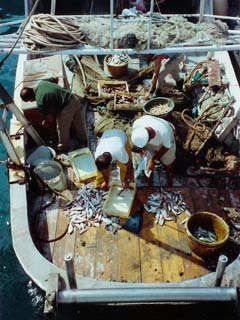 There were no taxis in Monterosso, so we walked to the hotel to pick up the key to our apartment. The town is bisected by a mountain reaching down to the water, with a tunnel connecting the two sides. The apartment was on the other side, in the older, more charming part of town, with its brightly painted buildings, quaint shops, and narrow alleyways. We climbed hundreds of steps up to our apartment. It was someone’s actual residence, containing their personal belongings, and the whole time we stayed there we kept expecting the owners to return and throw us out! Probably it was just an opportune way for the hotel clerk to make some money by subletting his own place. In any event, we spent a few days there without incident, and had the added convenience of a washing machine.
There were no taxis in Monterosso, so we walked to the hotel to pick up the key to our apartment. The town is bisected by a mountain reaching down to the water, with a tunnel connecting the two sides. The apartment was on the other side, in the older, more charming part of town, with its brightly painted buildings, quaint shops, and narrow alleyways. We climbed hundreds of steps up to our apartment. It was someone’s actual residence, containing their personal belongings, and the whole time we stayed there we kept expecting the owners to return and throw us out! Probably it was just an opportune way for the hotel clerk to make some money by subletting his own place. In any event, we spent a few days there without incident, and had the added convenience of a washing machine.
In spite of its seemingly small size, there is a lot to see and do in Monterosso. 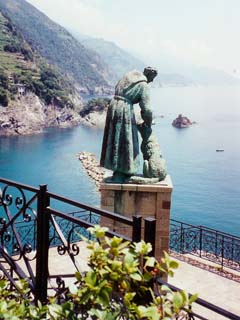 The harbor bustles with activity as fishermen mend their nets, repair their colorful boats or cast their rods from the dock. Tour boats offer excursions to the nearby coastal towns. There are many sidewalk cafes and outside restaurants. Several shops sell local products including wine, olive oil and the regional specialty, a lemon liqueur. The hills above town, accessible by hiking paths, offer extraordinary views of the coast and harbor. High above the tunnel is a statue of St. Francis of Assisi overlooking both sides of the town, a wonderful place for a picnic lunch. We have returned to this friendly town several times, once spending our entire vacation there.
The harbor bustles with activity as fishermen mend their nets, repair their colorful boats or cast their rods from the dock. Tour boats offer excursions to the nearby coastal towns. There are many sidewalk cafes and outside restaurants. Several shops sell local products including wine, olive oil and the regional specialty, a lemon liqueur. The hills above town, accessible by hiking paths, offer extraordinary views of the coast and harbor. High above the tunnel is a statue of St. Francis of Assisi overlooking both sides of the town, a wonderful place for a picnic lunch. We have returned to this friendly town several times, once spending our entire vacation there.
Our plan was to explore the other Cinque Terre towns, so we set out early one morning by boat to the furthest, Riomaggiore. Unlike the train, the boat offered us unobstructed views of the dramatically situated towns. Between them, the steep mountains were covered by terraced vineyards reaching all the way down to the Mediterranean.
Riomaggiori is arguably the most impressive of the towns, its buildings rising steeply from the ravine that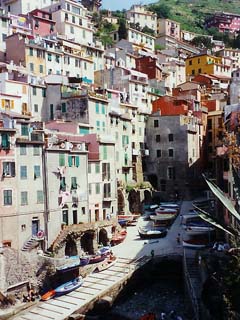 forms the harbor, so that from the water they appear to be stacked on top of each other. We climbed to a crumbling tower at the top of town, entranced by the smell of lemons permeating the air. From here, we could walk to the next town, Manarola, along the Via dell‘Amore, a walkway that hugs the cliffs. It was breathtaking and invigorating. Actually, an experienced hiker can visit all five towns via trails, but that that was a little too ambitious for us! In Manarola, we boarded the train to go on to the next town, Corniglia. The train station here is unbelievably picturesque, being open to the sea and profuse with flowers. I was so entranced by the station, at first I didn’t notice the town, which sat high on a cliff far above us. Faced with hundreds of steps to climb, we decided we didn’t really need to see Corniglia this trip. Boarding the train once again, we went on to Vernazza, a very pretty port. High above town is the Castello Doria, offering sweeping views of the town and coast. Just below the castle is an outdoor restaurant with the same views, and we decided to return there for dinner that night.
forms the harbor, so that from the water they appear to be stacked on top of each other. We climbed to a crumbling tower at the top of town, entranced by the smell of lemons permeating the air. From here, we could walk to the next town, Manarola, along the Via dell‘Amore, a walkway that hugs the cliffs. It was breathtaking and invigorating. Actually, an experienced hiker can visit all five towns via trails, but that that was a little too ambitious for us! In Manarola, we boarded the train to go on to the next town, Corniglia. The train station here is unbelievably picturesque, being open to the sea and profuse with flowers. I was so entranced by the station, at first I didn’t notice the town, which sat high on a cliff far above us. Faced with hundreds of steps to climb, we decided we didn’t really need to see Corniglia this trip. Boarding the train once again, we went on to Vernazza, a very pretty port. High above town is the Castello Doria, offering sweeping views of the town and coast. Just below the castle is an outdoor restaurant with the same views, and we decided to return there for dinner that night.
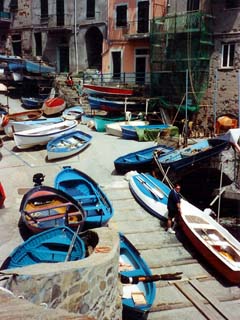 In the evening, we set out from Monterosso for the restaurant in nearby Vernazza, anticipating a memorable evening. We hopped the 7:30 train, and were immediately alarmed when the train picked up speed, since our stop was a very short distance away. As the train sped by our destination, I looked more carefully at the schedule only to realize this wasn't one of the local trains that stopped at all the towns. We were headed for La Spezia, about 20 minutes further away. We were not too dismayed, because it would still be early enough to head back to Vernazza for dinner.
In the evening, we set out from Monterosso for the restaurant in nearby Vernazza, anticipating a memorable evening. We hopped the 7:30 train, and were immediately alarmed when the train picked up speed, since our stop was a very short distance away. As the train sped by our destination, I looked more carefully at the schedule only to realize this wasn't one of the local trains that stopped at all the towns. We were headed for La Spezia, about 20 minutes further away. We were not too dismayed, because it would still be early enough to head back to Vernazza for dinner.
The train station in La Spezia has several tracks. The schedule showed our train left from track 1 at 8:15. As the time approached, with no trains in sight on track 1, a muffled announcement came over the loudspeaker on the platform. We heard the words Vernazza and binario cinque, track 5. Suddenly, people were making a mad dash across the tracks to a train further out, and just as we finally realized what the announcement must have said, the train pulled out of the station leaving us standing alone by track 1.
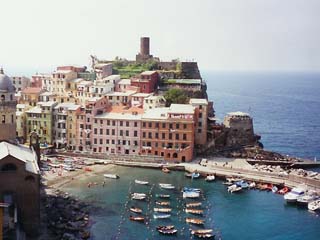 Annoyed at our bad luck, we still had an opportunity to get to Vernazza for dinner. We could catch the 9 PM train and arrive there a little on the late side, but Italians dine late so that would not present a problem. The schedule said the train left at 9 from track 1. By now we knew we had to be very cautious and keep watch for a train headed West toward Genoa at 9 PM. At 5 minutes to 9, a train pulled in on track 1 clearly marked for Genoa, our direction. Perfect! But, as soon as we boarded, the train began moving, and I saw that the platform clock showed it was not yet 9 PM. With a sinking feeling I realized it was not the right train. Asking a conductor, we discovered we were on our way to Genoa all right, non-stop. It was 1 1/2 hours past where we wanted to go. So, tired, discouraged, and very hungry, we had no choice but to settle down for the ride. In Genoa, we grabbed cold slices of pizza at a snack bar that was closing for the night, while we checked and double-checked the schedule for Monterosso. We finally reached our apartment at 1 AM. While far from the romantic evening we had envisioned when we set out many hours earlier, we had to admit it was memorable.
Annoyed at our bad luck, we still had an opportunity to get to Vernazza for dinner. We could catch the 9 PM train and arrive there a little on the late side, but Italians dine late so that would not present a problem. The schedule said the train left at 9 from track 1. By now we knew we had to be very cautious and keep watch for a train headed West toward Genoa at 9 PM. At 5 minutes to 9, a train pulled in on track 1 clearly marked for Genoa, our direction. Perfect! But, as soon as we boarded, the train began moving, and I saw that the platform clock showed it was not yet 9 PM. With a sinking feeling I realized it was not the right train. Asking a conductor, we discovered we were on our way to Genoa all right, non-stop. It was 1 1/2 hours past where we wanted to go. So, tired, discouraged, and very hungry, we had no choice but to settle down for the ride. In Genoa, we grabbed cold slices of pizza at a snack bar that was closing for the night, while we checked and double-checked the schedule for Monterosso. We finally reached our apartment at 1 AM. While far from the romantic evening we had envisioned when we set out many hours earlier, we had to admit it was memorable.
 The next day was the last day of our trip, and we decided to spend it in Asti, a town in the heart of the Piedmont wine region. Changing trains in Genoa, we realized it was the second time in less than 12 hours we had been to this station!
The next day was the last day of our trip, and we decided to spend it in Asti, a town in the heart of the Piedmont wine region. Changing trains in Genoa, we realized it was the second time in less than 12 hours we had been to this station!
It was a Sunday, and we arrived in Asti to discover the town filled with men in military uniforms with plumed hats. Fred immediately recognized them as Bersaglieri, soldiers highly revered for their bravery, like our Green Berets. Fred’s grandfather had been one, and we recalled a picture of him in that uniform. Festive posters around town advertised this weekend as the 38th reunion of the National Bersaglieri. We headed into the center of town, noticing the streets were lined with people, and realized a parade was imminent.

